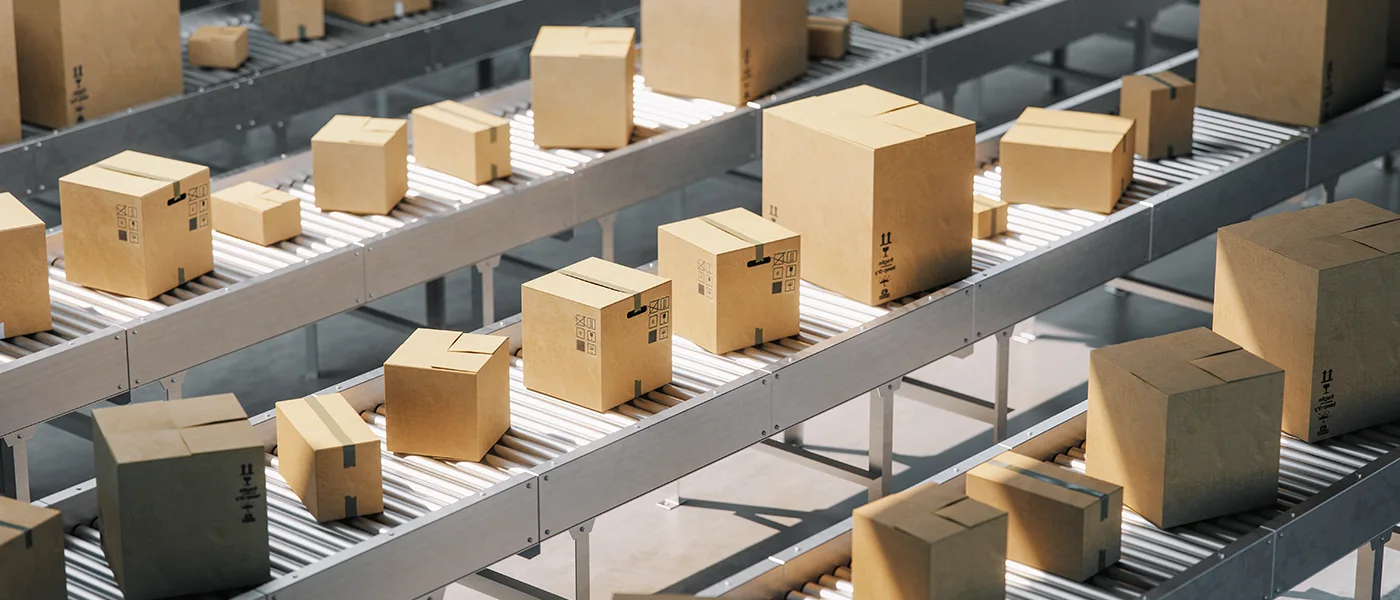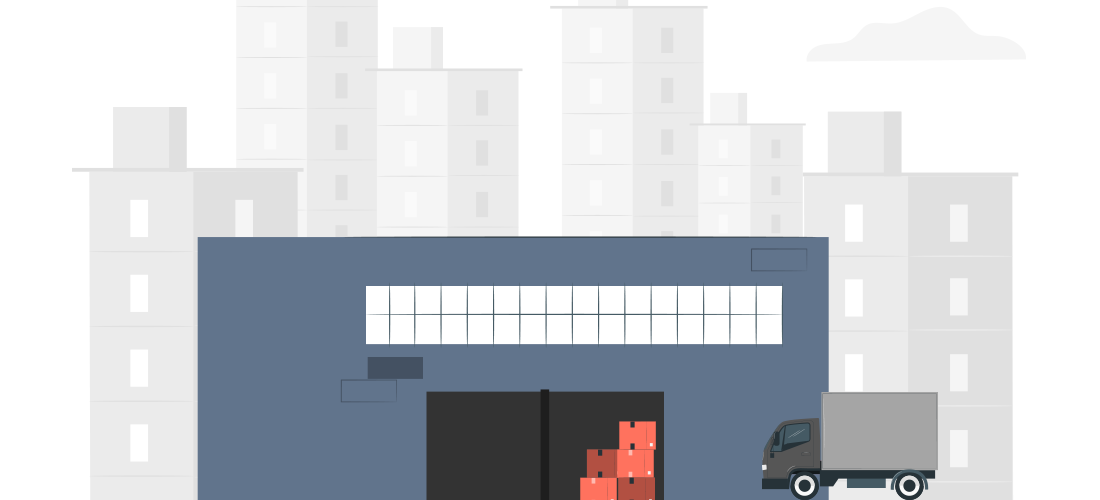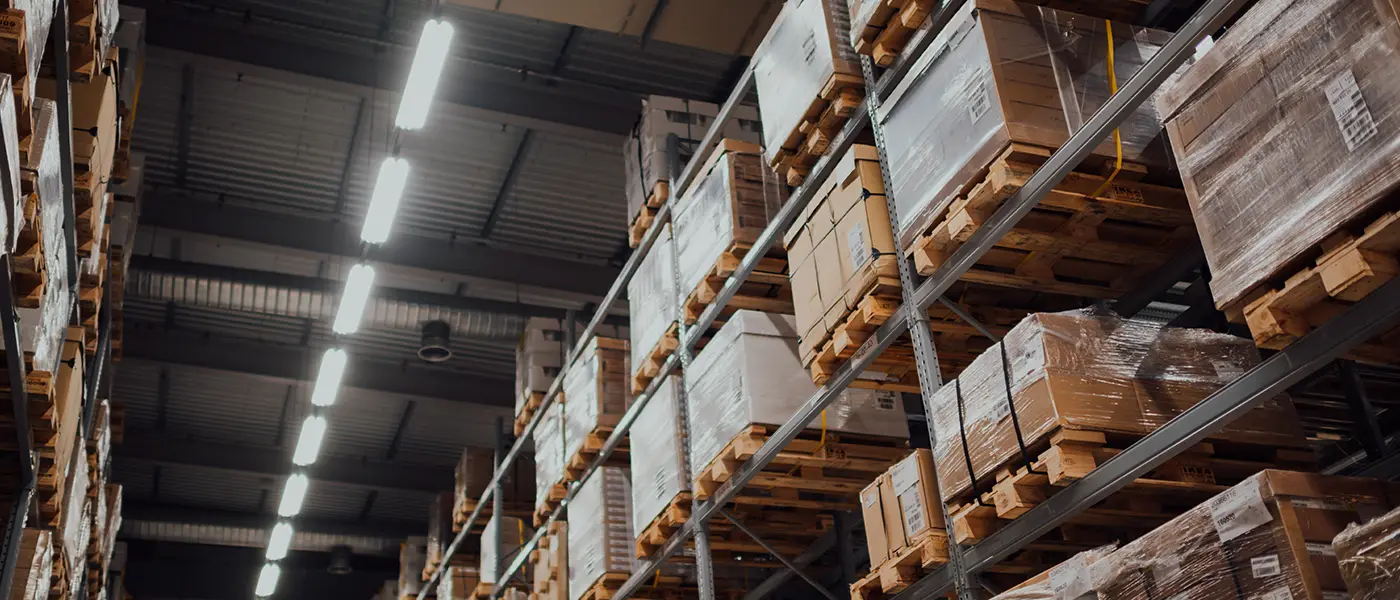Welcome to Locad’s comprehensive guide to distribution logistics. This article will explore the definition, types, examples, best practices, and actionable insights into distribution logistics.
Whether you’re an e-commerce business owner or a logistics enthusiast, this guide will provide you with the knowledge and tools you need to optimise your distribution operations. Get ready to delve into the world of distribution logistics and unlock the key strategies for success. Let’s get started!
What is Distribution Logistics?
Distribution logistics is a vital component of the broader logistics system, focusing on the production and market aspects. Specifically for direct-to-consumer brands (DTC), distribution logistics plays a crucial role in seamlessly delivering finished goods from manufacturers or suppliers directly to retailers, distribution centres, and customers, ensuring a smooth fulfillment process.
This subsystem encompasses essential planning tasks, control mechanisms, and processes that facilitate the efficient flow of goods between manufacturing companies, retailers, and customers. Its functions encompass material and goods handling, shipment and transportation, as well as interim storage. Distribution logistics acts as a bridge between production units and customers by establishing structural, organisational, operational, and informational connections.
A successful distribution system hinges on implementing sustainable structured information, effective decision-making, and control processes. These elements are pivotal in optimising distribution logistics, allowing businesses to achieve operational excellence, meet customer demands promptly, and maintain a competitive edge in the market.
Difference between Logistics and Distribution Logistics
Logistics and distribution logistics are related concepts but differ in scope and focus. Here’s a breakdown of their key differences:
| Factors | Logistics | Distribution Logistics |
Definition | The process of managing the flow and storage of goods, services, and information | The subset of logistics that focuses on the movement and management of goods from production to end customers |
| Scope | Covers the entire supply chain | Focuses on the distribution phase of the supply chain |
| Objective | Efficient flow and storage of goods | Smooth movement of goods from production to end customers |
| Activities | Procurement, transportation, inventory, etc. | Order processing, inventory control, packaging, transportation |
| Focus | Overall supply chain operations | Movement and management of goods in the distribution network |
| Main Goal | Optimising supply chain operations | Meeting customer demands and enhancing operational efficiency |
| End Point | Point of consumption | End customers, retailers, or distribution centres |
| Emphasis | Cost minimisation, customer satisfaction | Efficient distribution, timely delivery |
Primary Objectives of Distribution Logistics
The primary mission of distribution logistics is to balance the supply of goods in the market according to market demand.
The main objectives of distribution logistics are:
Availability of Goods
Ensuring a sufficient quantity of products is available is the primary objective of distribution logistics management. It aims to maintain optimal stock levels and timely replenishment to meet customer demand.
Cost Optimisation
Distribution logistics aims to reduce transportation, storage, product availability, and order processing costs. By optimising these costs, companies can achieve more structured, faster, time-efficient, and sustainable delivery.
Delivery Performance Optimisation
Providing on-time delivery to customers is crucial for building long-lasting and sustainable customer relationships. Distribution logistics focuses on proper planning and implementation to optimise delivery performance and meet customer expectations.
Efficient Information Flow
Effective logistics management relies on a transparent and efficient communication network. Distribution logistics aims to strengthen the flow of information within the business, allowing for better agility and responsiveness to market demands.
By pursuing these objectives, companies can enhance their distribution logistics operations, improve customer satisfaction, and gain a competitive edge in the market.
Inbound Vs Outbound Logistics: What’s the Main Difference?
Third-party logistics help your business grow by regulating order fulfillment. When you hire a 3PL supply chain company like LOCAD,…
Key Activities in Distribution Logistics Process
In distribution logistics, several key activities play a crucial role in ensuring the smooth flow of goods through the distribution network. Here are some of the key activities involved in the distribution logistics process:
Order Processing
Managing and processing customer orders, including order entry, verification, and order tracking.
Inventory Control
Monitoring and managing inventory levels to ensure optimal stock availability, minimising stockouts and excess inventory.
Packaging
Properly packaging products for safe and efficient transportation, considering factors like product protection, cost-effectiveness, and compliance with regulations.
Transportation Coordination
Planning and coordinating the transportation of goods, including selecting appropriate carriers, determining routes, and arranging shipment schedules.
Warehousing
Managing and operating warehouses or distribution centres for storing, consolidating, and distributing goods. This includes activities like receiving, storing, picking, and packing products.
Distribution Network Design
Strategically design the distribution network, including the number and location of warehouses or distribution centres, to optimise transportation costs, lead times, and service levels.
Shipment Tracking and Visibility
Monitoring and tracking the movement of goods throughout the distribution process, providing real-time visibility to customers and stakeholders.
Reverse Logistics
Managing the reverse flow of goods, including returns, repairs, and recycling, ensuring efficient handling of product returns and minimising associated costs.
Performance Measurement and Analytics
Monitoring and analysing logistics key performance indicators (KPIs) to assess the effectiveness and efficiency of distribution logistics operations, identifying improvement areas.
These activities collectively contribute to streamlining the distribution logistics process, ensuring timely delivery, minimising costs, and enhancing customer satisfaction.
Distribution Logistics Example
Let’s take an imaginary example of “SoleStyle,” the e-commerce shoe brand, to understand the distribution logistics process.
SoleStyle sources shoes from various manufacturers and suppliers. Once the shoes are ready for distribution, the distribution logistics process kicks in.
![Distribution Logistics: Definition, Objectives, Types, Examples & Best Practices [+Template] 3 SoleStyle’s Distribution Logistics Process](https://golocad.com/wp-content/uploads/2023/06/SoleStyles-Distribution-Logistics-Process-1.webp)
- Order Processing: SoleStyle receives customer orders through its website. The distribution team promptly verifies and processes these orders.
- Inventory Control: The team continuously monitors the shoe inventory, ensuring optimal stock levels. This prevents stockouts and excess inventory, improving efficiency.
- Packaging: Shoes are carefully packaged in appropriate boxes, considering protection and cost-effectiveness. The packaging reflects the brand’s identity and keeps shoes safe during transportation.
- Transportation Coordination: SoleStyle works with reliable carriers to transport the packaged shoes. The logistics team selects the best transportation modes and routes for efficient delivery.
- Warehousing: The brand operates strategically located distribution centres. Incoming shoes are received, sorted, and stored in the warehouses before further distribution.
- Distribution Network Design: SoleStyle has designed its distribution network to ensure quick and cost-effective deliveries. Warehouses are strategically placed to cover target regions effectively.
- Shipment Tracking and Visibility: Throughout the distribution process, SoleStyle keeps customers informed about the status of their shipments. Real-time tracking updates are provided to ensure transparency.
- Reverse Logistics: In case of returns or exchanges, SoleStyle efficiently manages the reverse flow of shoes, streamlining the return process and minimising customer inconvenience.
- Performance Measurement and Analytics: SoleStyle closely monitors key performance indicators, such as order fulfillment time and delivery accuracy. This allows them to evaluate and improve their distribution logistics operations.
By effectively implementing distribution logistics practices, SoleStyle ensures timely and accurate delivery of shoes to customers, maintaining customer satisfaction and driving business growth.
What is Distribution Channel?
Distribution Channels are the pathways by which the goods and services are provided from the source to the intended customer. Distribution Channels can be short or long, depending on the type and quantity of products delivered and the number of intermediaries associated with processing the fulfillment.
Types of Distribution Logistics Channels
When it comes to distribution logistics, businesses can utilise different channels to get their products into the hands of customers. Let’s explore three main types of distribution channels: direct, indirect, and mixed. Each channel has its own unique characteristics and considerations, allowing businesses to tailor their approach based on their specific needs and goals.
Direct Distribution Channel
In Direct Distribution Channel, businesses take complete control of the distribution process by selling and delivering products directly to customers.
By cutting out intermediaries, such as wholesalers or retailers, businesses can maintain greater control over pricing, branding, and customer relationships. However, direct distribution requires significant investment in infrastructure, inventory management systems, and logistics capabilities.
It’s a more hands-on approach that allows for a closer connection with customers and greater flexibility in managing the entire supply chain.
Advantages of Direct Distribution Channel
- Greater control over pricing, branding, and customer relationships.
- Direct access to customer feedback and preferences.
- Flexibility in adjusting strategies and making quick decisions.
- Potential for higher profit margins due to the elimination of intermediaries.
Disadvantages of Direct Distribution Channel
- Requires significant investment in infrastructure, inventory management systems, and logistics capabilities.
- Higher operational costs are associated with managing the entire distribution process in-house.
- Limited market reach compared to indirect channels.
- Increased responsibility for order fulfillment, customer service, and other logistical tasks.
Indirect Distribution Channel
Unlike direct distribution, the indirect distribution channel involves partnering with intermediaries to distribute and sell products. These intermediaries can include wholesalers, distributors, retailers, or third-party logistics providers (3PLs).
Indirect distribution offers several advantages, such as leveraging intermediaries’ existing network and expertise, reaching a wider customer base, and reducing the burden of managing certain logistical aspects.
However, businesses may have less control over pricing, branding, and customer interactions in the indirect channel.
Establishing strong partnerships and maintaining clear communication with intermediaries is important to ensure smooth operations and consistent customer experiences.
Advantages of Indirect Distribution Channel
- Broader market reach through the existing network and expertise of intermediaries.
- Reduced investment in infrastructure and logistics capabilities.
- Shared responsibility for order fulfillment, warehousing, and transportation.
- Access to established distribution channels and customer bases.
Disadvantages of Direct Distribution Channel
- Less control over pricing, branding, and customer interactions.
- Potential for higher costs due to intermediary fees and margins.
- Challenges in maintaining consistent customer experiences across various intermediaries.
- Limited access to customer feedback and preferences.
Mixed Distribution Channel
Many businesses adopt a mixed distribution approach that combines elements of both direct and indirect channels. This allows them to leverage the benefits of each approach while mitigating their respective limitations.
For example, a company may sell products directly to customers through their online store while also partnering with select retailers or utilising third-party fulfillment services for specific regions or markets.
The mixed distribution channel provides the flexibility to adapt to different market dynamics, target diverse customer segments, and optimise distribution efficiency.
Advantages of Mixed Distribution Channel
- Balances the benefits of direct and indirect channels.
- Allows for a broader market reach while maintaining control over certain aspects.
- Offers flexibility to adapt strategies based on specific regions or markets.
- Can leverage the expertise and resources of intermediaries in select areas.
Disadvantages of Mixed Distribution Channel
- Increased complexity in managing multiple distribution channels.
- Potential challenges in maintaining consistent branding and customer experiences across different channels.
- Requires careful coordination and communication among various partners.
- Higher administrative and operational overhead compared to a single-channel approach.
Multichannel Distribution: A comprehensive guide for business-owners
Welcome to the world of multichannel distribution! In today’s interconnected marketplace, businesses are constantly seeking innovative ways to reach and…
Other Types of Distribution Channels
In addition to the primary types of distribution channels (direct, indirect, and mixed), there are other channel variations based on the type of shipment. These variations involve different combinations of entities, including producers, wholesalers, retailers, and customers. Let’s explore these additional distribution channels:
Extended Distribution Channel
Extended Distribution Channel includes all four entities – producer, wholesaler, retailer, and customer. It follows a chronological supply framework, starting from the producer/manufacturer and ending with the consumer. The wine industry often operates through an extended distribution channel, with multiple intermediaries involved in the process.
Advantages of Extended Distribution Channel
- Access to a wider network of wholesalers, retailers, and distributors, expanding the product’s market reach.
- Increased visibility and availability of the product through multiple points of sale.
- Shared responsibilities and costs among the entities involved in the distribution process.
- Potential for economies of scale in production and distribution.
Disadvantages of Extended Distribution Channel
- Higher complexity in managing multiple intermediaries and coordinating supply chain activities.
- Longer lead times and increased risk of delays due to the involvement of multiple entities.
- Reduced control over pricing and branding as intermediaries may have their own strategies.
- Higher distribution costs due to additional margin requirements and fees from intermediaries.
Producer-to-Retailer Distribution Channel
The wholesaler is eliminated in this channel, and producers directly sell their products to retailers. Retailers, in turn, sell the products to the end consumer. This channel enables producers to establish a direct relationship with retailers and maintain greater control over the distribution process. Many technology firms like Dell and Apple operate through this distribution channel.
Advantages of Producer-to-Retailer Distribution Channel
- Direct relationship with retailers allows better control over product placement, pricing, and promotion.
- Ability to offer personalised support and incentives to retailers, fostering stronger partnerships.
- Increased flexibility to adapt to changing market conditions and consumer demands.
- Potential for higher profit margins by eliminating wholesaler margins.
Disadvantages of Producer-to-Retailer Distribution Channel
- Limited market reach compared to other channels that involve wholesalers.
- Additional responsibilities in terms of order fulfillment, logistics, and managing retailer relationships.
- Strong marketing and sales capabilities are needed to engage retailers and maintain loyalty.
- Higher costs associated with marketing and promotional activities to attract retailers and drive sales.
Direct-to-Consumer (D2C) Distribution Channel
D2C channel involves only the producer and the customer, cutting out intermediaries. It is a direct-to-consumer model where manufacturing units sell their products directly to customers. Amazon is a prime example of this distribution channel, selling Kindle ebook readers directly to the market without any interventions. This model reduces costs significantly and offers a streamlined distribution process.
Advantages of D2C Channel
- Complete control over the customer experience, including branding, pricing, and customer service.
- Direct access to customer data, enabling personalised marketing and targeted product offerings.
- Higher profit margins by eliminating intermediary markups and fees.
- Greater flexibility in adapting to changing consumer preferences and market trends.
Disadvantages of D2C Channel
- Need for robust e-commerce infrastructure and logistics capabilities to handle direct sales and distribution.
- Limited market reach compared to channels involving retailers or wholesalers.
- Increased marketing and promotional efforts are required to generate awareness and drive traffic to the D2C platform.
- Potential challenges in establishing and maintaining trust and credibility as a direct seller.
By considering these additional distribution channel variations, businesses can explore alternative strategies to meet their specific needs and optimise their distribution logistics.
Each channel has its own advantages and considerations, allowing businesses to choose the most suitable approach based on their industry, product characteristics, target market, and distribution goals.
How to Choose the Right Distribution Logistics Channel?
Choosing the right distribution logistics channel is a crucial decision for businesses. It involves evaluating various factors to ensure an effective and efficient distribution strategy. Here are key considerations to guide your decision-making process:
- Understand Your Business Goals: Start by clarifying your business objectives and long-term goals. Determine if you prioritise control, customer relationships, market reach, cost-effectiveness, or a combination of these factors.
- Know Your Target Market: Analyze your target market and customer preferences. Consider their buying habits, geographic location, and preferred channels for purchasing products. This insight will help you align your distribution strategy with their preferences.
- Evaluate Product Characteristics: Assess the nature of your products, including their size, fragility, shelf life, and storage requirements. Some products may require specialised handling or temperature-controlled storage, which could impact your distribution channel choice.
- Assess Resources and Capabilities: Evaluate your internal resources, including financial capabilities, infrastructure, inventory management systems, and logistics expertise. Determine if you have the necessary resources to handle in-house distribution or if outsourcing to intermediaries is more viable.
- Consider Cost and Scalability: Compare the costs associated with each distribution channel, including inventory holding costs, transportation expenses, and fees charged by intermediaries. Additionally, assess the scalability of each channel to accommodate potential business growth.
- Evaluate Control and Customer Experience: Determine the level of control you desire over pricing, branding, customer interactions, and the overall customer experience. Direct channels offer more control, while indirect channels may provide a broader reach but with less control.
- Research and Partner Evaluation: If considering indirect channels or third-party logistics providers, thoroughly research potential partners. Evaluate their reputation, reliability, geographic coverage, technological capabilities, and customer service to ensure they align with your distribution goals.
- Test and Monitor: Consider conducting small-scale tests or pilot programs to assess the performance and effectiveness of different distribution channels. Monitor key metrics, such as customer satisfaction, delivery speed, and cost efficiency, to make data-driven decisions.
Ultimately, the right distribution logistics channel will depend on a careful analysis of these factors and finding the balance that aligns with your business goals, target market, product characteristics, available resources, and desired level of control. Regularly reassess and adjust your distribution strategy as your business evolves and market dynamics change.
Common Challenges of Distribution Logistics
Distribution logistics faces several challenges businesses must overcome for efficient and effective operations. Here are some common challenges:
- Inventory Management: Balancing inventory levels to meet customer demands while minimising holding costs and stockouts.
- Supply Chain Visibility: Ensuring real-time visibility across the entire supply chain to track shipments, anticipate delays, and manage exceptions.
- Transportation Optimisation: Optimising transportation routes, modes, and carriers to reduce costs, improve delivery times, and enhance overall efficiency.
- Warehouse Efficiency: Maximising warehouse space utilisation, streamlining picking and packing processes, and improving inventory accuracy.
- Last-Mile Delivery: Overcoming the complexities of last-mile delivery, including congested urban areas, time-specific deliveries, and customer preferences.
- Reverse Logistics: Managing returns, repairs, and product recall efficiently, including reverse transportation, sorting, and disposition processes.
- Technology Integration: Integrating various logistics technologies, such as warehouse management systems (WMS), transportation management systems (TMS), and order management systems (OMS), to ensure seamless information flow and process automation.
- Global Logistics: Overcoming challenges related to international trade and logistics, customs regulations, cross-border transportation, and compliance with export/import requirements.
- Customer Expectations: Meeting evolving customer expectations for faster delivery, real-time tracking, personalised experiences, and convenient returns.
- Sustainability: Balancing environmental sustainability goals with logistical efficiency, including reducing emissions, optimising packaging, and implementing green transportation practices.
By addressing these challenges proactively, businesses can enhance their distribution logistics operations, improve customer satisfaction, and gain a competitive edge in the market.
Best Practices for Optimising Distribution Logistics
Some crucial measures to manage and optimise distribution logistics more effectively are:
Sustainable Planning Strategy
The critical aspect of developing efficient distribution logistics management is implementing the correct planning. A Sustainable Planning Strategy includes procuring goods, planning the delivery chain, storing and inventory management, etc.
Sustainable planning results in completing the process in a lesser time with reasonable budget limits, leading to maximised revenue. Structured planning accounts for the practical success of logistics management.
Demand Forecasting
Data-driven, accurate demand forecasts are essential for making informed decisions. The right technology provides the right tools and metrics to ensure a precise market scenario and makes way to replenish inventory on time.
Accurate demand forecasts help optimise inventory, minimise product shrinkage, optimise shipping charges, and maintain consistent customer service.
Leveraging Technology & Software
With the ever-increasing flow of information, technology is the future of e-commerce. The vast opportunities to integrate technology and software ensure a clean and seamless business automation prospect.
Implementing the right technology helps in improving different aspects of distribution logistics. Automated system inventory provides real-time monitoring fulfillment and a faster shipping experience.
Outsourcing
The most efficient way of ensuring a smoother distribution is by partnering with outsourced partners or third-party logistics providers. Outsourced distribution partners help provide the best services for fulfillment and take care of warehousing and distribution. This helps reduce costs with faster and more accurate fulfillment processes to improve customer service.
How Locad Can Be Your Trusted 3PL Partner?
Locad is a leading 3PL (third-party logistics) provider for Asia Pacific e-commerce businesses’ logistics and shipping needs. With our expertise and advanced technology-driven solutions, we can be your trusted partner in optimising your supply chain and streamlining your distribution processes. Here’s why you can rely on Locad:
- Seamless Integration: Locad offers seamless integration with your existing systems, including e-commerce platforms, order management systems, and inventory management tools. This ensures smooth data flow, real-time visibility, and accurate tracking of your inventory and shipments.
- Advanced Warehousing Capabilities: Our state-of-the-art warehouses are strategically located in key regions, enabling faster and cost-effective order fulfillment. Our efficient warehouse management system (WMS) ensures accurate inventory management, optimised storage, and streamlined picking and packing processes.
- Global Distribution Network: Locad has a robust global distribution network across the Asia Pacific region, allowing you to reach customers globally. Whether you need local or cross-border distribution, we have the infrastructure and expertise to handle your shipments seamlessly, ensuring timely and reliable deliveries.
- Technology-driven Solutions: Leveraging cutting-edge technologies like artificial intelligence and machine learning, Locad provides data-driven insights, demand forecasting, and inventory optimisation. Our intelligent algorithms help you make informed decisions, minimise stockouts, and improve overall operational efficiency.
- Scalable and Flexible Operations: We understand that e-commerce businesses experience fluctuating demands. Locad offers scalable and flexible operations, allowing you to adapt to seasonal peaks, promotional events, and market fluctuations. Our agile approach ensures that your distribution logistics can support your business growth.
- Transparent and Proactive Communication: Communication is key to a successful partnership. Locad maintains transparent and proactive communication channels, keeping you informed about the status of your shipments, inventory levels, and any potential issues. Our dedicated customer support team is always available to address your queries and provide assistance.
- Focus on Customer Satisfaction: At Locad, customer satisfaction is at the core of everything we do. We prioritise delivering an exceptional customer experience, meeting your service level agreements, and exceeding your expectations. Your success is our success, and we strive to build long-term partnerships based on trust and mutual growth.
Partnering with Locad for your distribution logistics needs ensures a reliable and efficient supply chain, allowing you to focus on your core business activities. With our expertise, technology-driven solutions, and commitment to customer satisfaction, Locad is the trusted 3PL partner you can rely on to optimise your distribution operations and drive your e-commerce success.






